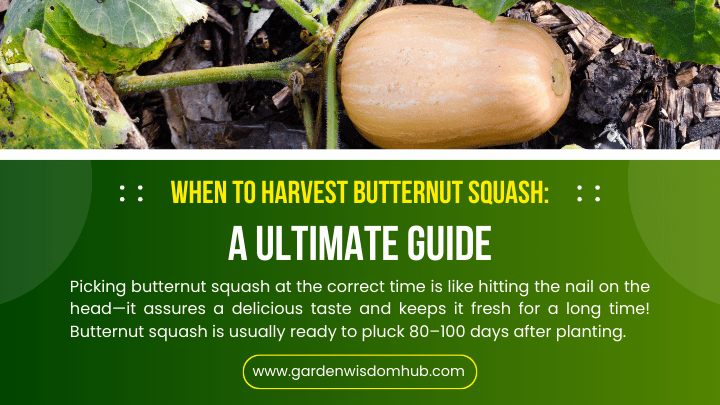When to Harvest Butternut Squash?
Picking butternut squash at the correct time is like hitting the nail on the head—it assures a delicious taste and keeps it fresh for a long time! Butternut squash is usually ready to pluck 80–100 days after planting.
Waiting for the kettle to boil requires patience! Mother Nature’s temperament and breed may affect the clock. Butternut squash, unlike other fruits, doesn’t ripen once off the vine, thus timing is everything.
How do you know when butternut squash is ripe?
Butternut squash has several signals that it’s ready to harvest:
Colour:
The squash should be tan or beige, avoiding green like a cat avoiding a bath. Green as a gourd, immature squash has a lustrous, glossy appearance like a new penny!
Texture:
The skin should be rough like old boots. It should be as safe as a feather on a breeze to pierce the skin to check for ripeness!
Stem Condition
The squash should have absorbed all its nutrients, leaving the stem dry and corky.
Vine Condition:
When the vine gives up, the squash is ready to shine.
Can you leave butternut squash on the vine too long?
You can leave that butternut squash on the vine when it’s mature, but if you wait too long, it may be past its prime, like milk left out on a hot day!
When squash gets too comfortable on the vine, it may develop dull, wrinkled skin from being overworked! And inside? It might become a stringy mess, losing its texture and flavour. The squash has lost its appeal! Choose when the symptoms of ripeness are obvious to avoid over ripeness.
What happens if you pick butternut squash too early?
If you pick your butternut squash too early, it may taste like a wet sock and be as sweet as a sour lemon! Early-picked squash is watery and lacks maturity’s firm, rich flavour.
It seems it missed the taste train by jumping the gun! With a skin so thin it could be tissue paper, greenhorn squash is delicate like a flower! This leaves it vulnerable to breakage, decay, and a storage life shorter than a cat’s attention span. You can try to ripen it off the vine by putting it in a warm, sunny area, but it won’t have the same flavour as one that’s been picked at its prime.
How do I know when my squash is ready to pick?
In addition to the signals on the table, the ‘tapping test’ can determine ripeness. If that squash echoes like a drum, it’s ready to pluck! If the voice sounds flat as a pancake, it may be too early to retire. Watch the squash’s skin, stem, and vine for indicators that it’s time to strike while the iron is hot!
Growing Butternut Squash
Butternut squash soaks up the light and needs 75–100 days to mature! Butternut squash needs these to thrive:
Full Sunlight:
6-8 hours of sunshine to keep those plants happy!
Well-Drained Soil:
The soil should be rich in organic matter and drain like a sieve on rainy days. Spreading compost or well-aged manure before planting is like giving your earth a hearty breakfast—it gets things cooking!
Watering:
Soak it occasionally to help those roots dig in like treasure hunters! Check your step or you could drown your roots and have root rot and pull out your hair!
The space:
Like cats in the sun, butternut squash plants need space to expand!
These plants cover 20-50 square feet apiece with vines that extend like cats on sunny windowsills! Like an overstaying houseguest! Trellises or support structures let plants reach towards the sky while keeping everything shipshape and Bristol-style!
When is Butternut Squash Ripe?
To determine butternut squash ripeness, look at its colour, squeeze it for texture, and examine the stem—it’s all in the details!
Colour:
Like a freshly baked pie, the squash should be a rich, deep tan or beige.
Texture:
Skin should be as hard as nails and as solid as brick.
Stem:
A dry, corky stem indicates that the squash has cut the apron strings from the vine and is ripe like a peach!
Butternut Squash Ripening Stages:
Following are The Many stages of Butternut Squash Ripening
Immature Stage:
The squash is green like a gourd, soft like a marshmallow, and has a stem as flexible as a trampoline gymnast. Still in the oven, not baked!
Transition
The skin tans and the fruit toughens up like a veteran. It’s almost done, although it may still be green around the gills.
Maturity:
The skin is deep tan, the stem is dry, and the body feels solid. Reap what you sow now!
Overripe Stage:
If you leave it on the vine longer than a cat on a hot tin roof, the skin will wrinkle and the meat will stringy like a bad joke that won’t stop.
Harvesting Butternut Squash
When harvesting butternut squash, use a sharp knife or garden shears to cut the fruit off the vine, leaving 2-3 inches of stem as a devoted companion!
This protects the squash from bugs and extends its shelf life, like a nine-lives cat! A bruised squash can go bad faster than you can say ‘rotten tomato’ in storage, so treat it like a hot potato!
Can you Harvest Butternut Squash Early?
Butternut squash can be picked before it’s ready, but that’s not recommended! Early-harvested squash lacks flavour and sweetness and has a thin skin like a house of cards, ready to rot and damage! In case of frost or other weather surprises, it may be best to cut the cord and harvest early!
Giving a squash time to bask in a warm, dry place will help it sweeten and ripen like a superb wine.
Curing and Storing Butternut Squash:
After enjoying the benefits, give that butternut squash some TLC to keep it fresh! Jump on this instructional merry-go-round:
Healing:
Let the squash sit in a warm, dry spot with a breeze (75-85°F) for a few weeks. This toughens the skin, making it more resistant to spoiling. After cleaning the squash, store it in a cool, dry place with a 50–55°F thermometer.
Avoid the heat of moment! The solution is a root cellar, pantry, or basement! Keep mould and decay away by making the storage room airy! Keep that butternut squash in good form and it can last 3–6 months without a problem!
How to Harvest Butternut Squash Seeds?
- Choose a squash as tough as nails with beach-tan skin.
- Cut the squash in half and remove the seeds like a treasure hunt!
- Remove those seeds from the pulp and wash them well under a stream.
- Let those seeds dry out in a warm, dry area in the sun for 1-2 weeks like a tropical vacation!
- Store dried seeds in an airtight container in a cool, dry place like a bug in a rug! Butternut squash seeds can last 3–4 years if stored properly like acorns.
Final Curtain Call : When to Harvest Butternut Squash
Growing and harvesting butternut squash is like winning the vegetable lottery! It’s rewarding and can yield a delightful and versatile kitchen gem. By understanding the growth stages, identifying when your squash is ready to go, and using the appropriate harvesting techniques, you can ensure top-notch flavour and keep your butternut squash around!
Keep a watch out and be patient as those squash mature! Remember, a stitch in time saves nine—cure and store that harvest well and you’ll be eating squash for months! With a little care and elbow grease, your garden will be plenty with delicious butternut squash to spice up your meals!
Frequently asked questions: When to Harvest Butternut Squash:
If you have any questions you can checkout our faqs:
How to tell if butternut squash is ripe?
Look for tan or beige skin as tough as nails and a dry, corky stem that might outperform a tree! Roll up your sleeves and pick that squash when the skin is solid as a drum and the vine is wilting!
Can you keep butternut squash on the vine longer than a scorched tin roof cat?
It appears we’ve reached a snag! Finding a needle in a haystack, right? Don’t worry—we’ll launch this program soon! Hang tight—we’ll turn this frown around. If you leave the squash on the vine like a wallflower at a dance, it will turn mushy quickly!
The skin may resemble a crumpled paper bag and the meat may become tough like an old boot, making it as good as a chocolate teapot for quality and storage.
What happens if you buy butternut squash before it’s ready?
A veggie may be rough as nails and insipid as dishwater! Try catching a fish with your bare hands bad idea! Wait till that squash is perfect before acting! Early picking produces squash as sweet as a sour lemon and flavourless as a wet blanket. Green squash is like a thin-skinned puppy, ready to give up and spoil before you can say “Jack Robinson!”
Can butternut squash ripen quickly?
You can give the squash a nice position in a warm, dry corner to mature, but if you pluck it too soon, it may taste flat like a pancake and have poor quality!
How to heal butternut pumpkins?
Give your squash a two-week break in a warm, dry place where the air can dance. The royal treatment and good circulation will get it ready to roll in no time! This toughens the skin and extends its shelf life, like a pickle in a jar!
How to keep butternut squash daisy-fresh?
Store cured squash in a cool, dry place, such a cellar or pantry, between 50-55°F (10-13°C), so it can sit beautiful and not overheat! If you store squash properly, it can survive 3–6 months—talk about a long-term relationship!
Can I get butternut squash seeds for a rainy day?
Absolutely! Get those ripe butternut squash seeds out, rinse them, then dry them like wine to conserve them! Easy peasy, right? To grow daisies, store those seeds in a cool, dry place and use them within 3–4 years!
James Porter
Welcome to our haven of gardening and plant care, where outdoor and indoor planting enthusiasts come together! At Gardening Wisdom Hub, we aim to provide you with the most authentic information on anything related to gardening, plant care, seasonal planting etc.
The author of our website is James Porter, an experienced industry veteran. He has a deep interest in everything green. James’s enthusiasm for exploring plants’ features and learning new gardening methods began at a young age. Gradually, his passion increased with time, leading him to become a highly esteemed professional. His extensive knowledge makes him a priceless resource for inexperienced and seasoned gardeners.

